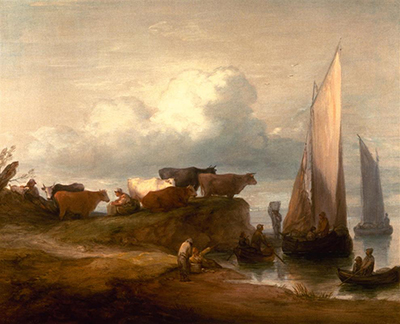Gainsborough painted A Coastal Landscape between 1782 and 1784. It is an oil on canvas painting that measures 76cm x 63cm. It's thought that the work was something he did for his interest and not as a commission.
Over the years the picture has had many owners. In 1998, William Berger and Bernadette Johnson Berger acquired the painting for the Berger Collection Educational Trust in Denver. In 2019, the Trust made a gift of A Coastal Landscape to the Denver Art Museum. The painting had been on show in the museum between 2014 and 2018. The painting depicts a rural scene on the coast. In the picture, Gainsborough focuses on the cows, people and sailboats on the headland and in the water. What is unusual about the work is how Gainsborough treats space and scale. For example, compared with the sailboat next to the headland, the cows appear too large. It suggests that Gainsborough may have painted A Coastal Landscape in his studio rather than outdoors.
As an artist, Gainsborough was technically proficient at his work. He was, however, someone who liked to experiment. Those who knew him commented on the speed that he could put paint on canvas. When it came to technique, rather than follow any formal rules, Gainsborough would base his work on his observations of nature. Thomas Gainsborough was a renowned English painter of the 18th-century, best known for painting portraits such as The Blue Boy and The Market Cart. As well as portraits, he was also a painter of landscapes such as A Coastal Landscape.
While Gainsborough is best known for his portraits, he preferred painting landscapes. His passion for painting landscapes is visible in the way that he could combine portrait figures with the scenes behind them. Gainsborough’s technique for painting landscapes often included him working at night by candlelight. He also made use of a gadget that he called a ‘Showbox’. It allowed Gainsborough to compose landscapes and view them in the glass, illuminated from behind. Towards the end of his career, Gainsborough made use of a light palette and strokes that were easy and economical in his paintings.




